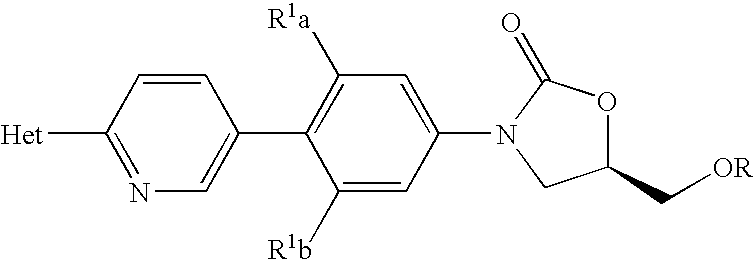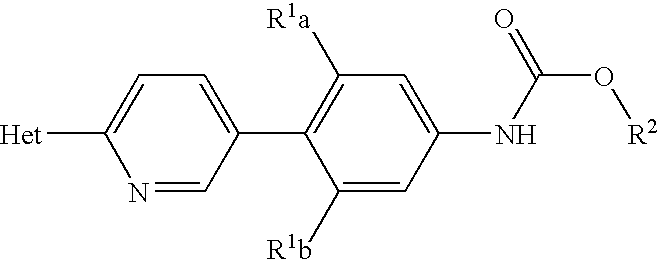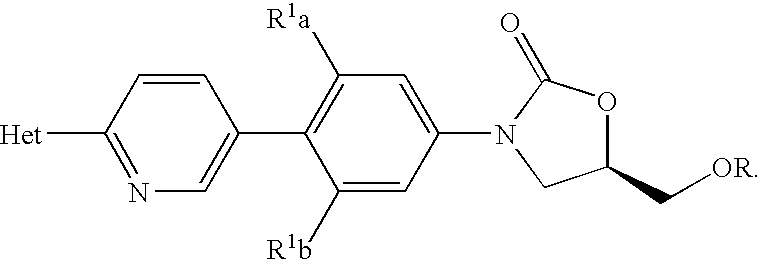Methods for preparing oxazolidinones and compositions containing them
a technology of oxazolidinone and composition, which is applied in the field of preparation of oxazolidinonecontaining compounds, can solve the problems that the use of tin compounds in the presence of tin compounds is not desirable, and achieves the effect of improving the stability and stability of tin compounds
- Summary
- Abstract
- Description
- Claims
- Application Information
AI Technical Summary
Benefits of technology
Problems solved by technology
Method used
Image
Examples
example 1
Preparation of 5-Bromo-2-(2H-tetrazol-5-yl)pyridine, 3
[0081]To a 22-L, three-neck, round-bottom flask equipped with an overhead stirrer, nitrogen inlet / outlet, thermocouple and heating mantle was charged 5-bromo-2-cyanopyridine (799 g, 4.37 mol, 1 weight), N,N-dimethylformamide (6.4 L, 8 volumes), ammonium chloride (350.3 g, 6.55 mol, 1.5 equivalents), and sodium azide (425.7 g, 6.55 mol, 1.5 equivalents) while stirring. The internal reactor temperature set-point was adjusted to 85° C. (Target temperature is 90° C.). The temperature set-point was reached after 45 minutes, and the reaction continued to self-heat to 94° C. over 40 minutes. The reaction was judged to be complete after 1 hour by HPLC analysis by complete consumption of the starting material with an assay of 76.7% (AUC) of the tetrazole ammonium salt. The mixture was cooled and filtered at room temperature. The reactor and wet cake were washed with 2-propanol (3.2 L, 4 volumes) and dried under high vacuum at ambient temp...
example 2
Preparation of 5-Bromo-2-(2-methyl-2H-tetrazol-5-yl)pyridine, 4 (X═Br)
[0082]To a 22-L, four-neck, round-bottom flask equipped with an overhead stirrer, nitrogen inlet / outlet, and thermocouple placed in an ice / brine bath was charged the tetrazole ammonium salt (835.0 g, 3.44 mol, 1 weight), tetrahydrofuran (7.5 L, 9 volumes), N,N-dimethylformamide (2.5 L, 3 volumes) and sodium hydroxide powder (343.5 g, 8.59 mol, 2.5 equivalents) while stirring. The internal reactor temperature was allowed to reach 12° C., whereupon iodomethane (1.22 kg, 8.59 mol, 2.5 equivalents) was added dropwise over 50 minutes, maintaining the reaction temperature below 20° C. After 20 minutes addition time, due to a rapid increase in temperature, the addition was paused and the reaction continued to self-heat from 15-20° C. over ten minutes. The remainder of the addition was completed at constant temperature (18° C.). Upon completion of the addition, the ice / brine bath was removed and the reactor was equipped w...
example 3
Preparation of benzyl (4-bromo-3-fluorophenyl)carbamate, 5
[0085]To a 12-L, three-neck, round-bottom flask equipped with an overhead stirrer, nitrogen inlet / outlet, addition funnel and thermocouple was charged 4-bromo-3-fluoroaniline (800.0 g, 4.21 mol, Matrix lot #Q13H), THF (6.4 L, 8 vol), and solid sodium bicarbonate (530.5 g, 6.32 mol, 1.5 eq). The addition funnel was charged with benzyl chloroformate (861.9 g, 5.05 mol, 1.2 eq), which was added dropwise to the reactor over 70 minutes. The temperature of the reaction was maintained below 20° C. with an ice water bath. The batch was aged 1 hour at room temperature at which point HPLC analysis indicated that the reaction was complete. The reaction mixture was transferred to a 22-L flask and the mixture was diluted with water (6.4 L, 8 vol). The two-phase mixture was warmed to 50° C. and held at temperature for 16 hours to quench the excess benzyl chloroformate. The mixture was transferred hot to a separatory funnel to remove the lo...
PUM
| Property | Measurement | Unit |
|---|---|---|
| temperature | aaaaa | aaaaa |
| temperature | aaaaa | aaaaa |
| temperature | aaaaa | aaaaa |
Abstract
Description
Claims
Application Information
 Login to View More
Login to View More - R&D
- Intellectual Property
- Life Sciences
- Materials
- Tech Scout
- Unparalleled Data Quality
- Higher Quality Content
- 60% Fewer Hallucinations
Browse by: Latest US Patents, China's latest patents, Technical Efficacy Thesaurus, Application Domain, Technology Topic, Popular Technical Reports.
© 2025 PatSnap. All rights reserved.Legal|Privacy policy|Modern Slavery Act Transparency Statement|Sitemap|About US| Contact US: help@patsnap.com



